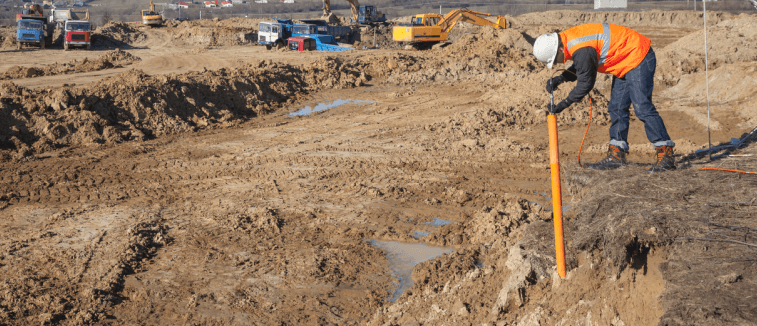Geotheta Things To Know Before You Buy
Table of ContentsGeotheta - TruthsSome Known Incorrect Statements About Geotheta Rumored Buzz on GeothetaExcitement About GeothetaThe Best Strategy To Use For Geotheta

They conduct site examinations, collect samples, execute laboratory examinations, and examine data to examine the suitability of the ground for building and construction projects - Geo Tech Engineering. Based upon their searchings for, geotechnical designers give recommendations for structure style, slope stability, retaining structures, and mitigation of geotechnical hazards. They work together with various other professionals, such as engineers, architectural designers, and building groups, to guarantee that geotechnical considerations are integrated into the total job design and application
By assessing the habits and homes of dirt and rock, they can determine prospective geotechnical threats such as landslides, dirt settlement, or slope instability. Their expertise helps avoid failures or crashes that might jeopardize lives and residential or commercial property. Right here are some detailed duties and responsibilities of a geotechnical designer: Site Investigation: Geotechnical engineers conduct site investigations to gather data on subsurface conditions.
They interpret the information to understand the buildings and habits of the soil and rock, including their stamina, permeability, compaction characteristics, and groundwater conditions. Geotechnical Analysis and Style: Geotechnical engineers examine the information collected during site investigations to evaluate the stability and suitability of the website for building tasks. They perform geotechnical calculations and modeling to examine elements such as bearing capacity, settlement, incline stability, lateral planet pressures, and groundwater circulation.
The Best Guide To Geotheta
Foundation Layout: Geotechnical engineers play a critical function in designing structures that can securely sustain the designated framework. They assess the dirt conditions and tons demands to identify the proper structure kind, such as shallow structures (e.g., grounds), deep foundations (e.g (https://hearthis.at/geotheta/set/geotheta/)., stacks), or specialized techniques like soil renovation. They consider variables such as settlement limits, birthing ability, and soil-structure communication to create optimal foundation designs
They evaluate construction strategies, monitor website tasks, and perform area inspections to confirm that the design referrals are followed. If unforeseen geotechnical concerns arise, they assess the scenario and supply referrals for removal or modifications to the design. Danger Evaluation and Reduction: Geotechnical engineers evaluate geotechnical risks and risks connected with the project website, such as landslides, liquefaction, or soil erosion.

Collaboration and Communication: Geotechnical engineers function carefully with other professionals included in a job, such as engineers, structural designers, and building and construction teams. Reliable interaction and cooperation are necessary to incorporate geotechnical considerations right into the overall task design and building process. Geotechnical designers offer technological expertise, response questions, and make sure that geotechnical demands are satisfied.
What Does Geotheta Mean?
Below are some kinds of geotechnical engineers: Structure Engineer: Foundation designers focus on making and assessing foundations for frameworks. They assess the soil problems, lots demands, and website features to identify the most ideal foundation type and design, such as shallow structures, deep structures, or specialized strategies like stack structures.
They examine the factors influencing incline security, such as soil residential or commercial properties, groundwater conditions, and incline geometry, and create approaches to prevent slope failures and reduce dangers. Earthquake Engineer: Quake engineers specialize in examining and creating frameworks to stand up to seismic pressures. They assess the seismic danger of a site, review dirt liquefaction potential, and establish seismic design criteria to ensure the safety and security and strength of frameworks during earthquakes.
They execute field screening, gather samples, and evaluate the accumulated information to characterize the dirt homes, geologic developments, and find this groundwater problems at a website. Geotechnical Instrumentation Designer: Geotechnical instrumentation engineers concentrate on surveillance and gauging the behavior of dirt, rock, and structures. They mount and preserve instrumentation systems that check elements such as soil negotiation, groundwater degrees, slope movements, and structural variations to examine performance and offer early warnings of potential problems.
8 Simple Techniques For Geotheta
They perform tests such as triaxial examinations, loan consolidation tests, direct shear examinations, and permeability tests to gather information for geotechnical evaluation and layout. Geosynthetics Designer: Geosynthetics designers specialize in the layout and application of geosynthetic products, such as geotextiles, geogrids, and geomembranes. They make use of these materials to improve dirt stability, reinforce inclines, provide water drainage solutions, and control disintegration.
They often tend to be investigative individuals, which implies they're intellectual, introspective, and analytical. They are interested, methodical, reasonable, logical, and sensible. Some of them are additionally social, meaning they're kind, generous, participating, patient, caring, useful, empathetic, sensible, and friendly - Geotechnical Engineers.
In the office atmosphere, geotechnical designers use specialized software program devices to carry out computations, develop designs, and examine data. They prepare reports, testimonial task specs, interact with clients and employee, and coordinate task tasks. The office setting offers a conducive setting for research study, analysis, and collaboration with various other experts associated with the project.
Getting The Geotheta To Work
They often see task sites to carry out website investigations, analyze geotechnical problems, and gather information for evaluation. These gos to involve traveling to various locations, sometimes in remote or difficult terrains. Geotechnical designers may execute dirt sampling, conduct examinations, and screen construction tasks to make sure that the geotechnical aspects of the task are being implemented appropriately.
Geotechnical designers likewise function in specialized geotechnical research laboratories. Geotechnical laboratory engineers work extensively in these environments, managing screening devices, operating instruments, and taping information.